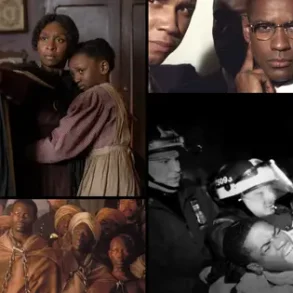“Look at me now.”
David Garcia meant those words for the school administrators who had written him off.

His message — tinged with defiance, triumph, perhaps even pride — was about defying the odds for a high school dropout who longed for a diploma, but whose life has taken all too predictable detours. In June, he walked the stage to accept his diploma from Vista Academy in Montbello. He did so with a lot of help, determination and grit.
But Garcia’s story is complicated.
He faces a fork in the road. One path offers him the new chance promised by his educational achievement. The other is less certain as he faces new legal trouble with the courts, the gravity of his previous life tugging at him.

Graduate David “Rico” Garcia shakes hands with school and district administrators as he walks during Vista Academy’s graduation ceremony on Friday, June 2, 2023, at Evie Garrett Dennis Stadium in Denver. (Timothy Hurst/Denver Gazette)
Three years ago, Garcia said he was expelled by a Denver Public Schools (DPS) administrator who believed he was the target — and therefore a security risk — of a drive-by shooting that wounded a female classmate near Martin Luther King Jr. Early College in 2019.
After his expulsion, Garcia, then a minor, spent the next two years on hot roofs working for his dad and flipping burgers in fast-food restaurants, while trying to find a high school that would accept him. But he also had a run-in with the law and then a new brush with criminality. This year, Garcia was charged with attempted aggravated robbery and second-degree assault, stemming from a case in which police alleged last year he and three minors planned and then attempted to rob two minors, one of which had a BB gun they believed to be a real handgun.
Young people involved in violent crime are at the center of a debate over how best to ensure their education. Some argue for better tracking of such cases and a Bill of Rights to give students charged criminally the attention they need. Broadly speaking, the idea has attracted the support of Denver Public Schools, but also pushback from others concerned other children could be placed in peril.
A Bill of Rights
While it is unlikely that Garcia is the only “justice-engaged” student in Colorado to have dropped out and then graduate, very little is known about this cohort. That’s because the Colorado Department of Education (CDE) does not — nor does it require school districts to — track the educational outcomes of students like Garcia.
“I think that’s one of the issues,” said Wendy Loloff Cooper, CEO of Generation Schools Network (GSN). “School districts aren’t forced to track these numbers and what happens to kids.”
Founded in 2006, GSN is a nonprofit organization in Denver that seeks to help every student thrive in school, work and life.
A local effort — still in its infancy — seeks to help students who’ve had encounters with the legal system graduate from high school via a Justice Engaged Student Bill of Rights, designed to eliminate barriers and create pathways to school re-entry.
Put simply, “justice engaged” or “justice involved” students are youth who have come into contact with the criminal justice system either as victims, offenders or witnesses. Advocates and school officials alike use this language to describe students like Garcia who may or may not be adjudicated.
Because earning a diploma is correlated with financial attainment and the graduation path for these youth is not straight, Cooper hopes to call greater attention to this issue and raise awareness about their effort to create a Justice Engaged Student Bill of Rights.
“If we want to improve this, we have to track it,” Cooper said.
‘Two systems at play’
If successful, such a bill of rights in Colorado would likely be the first of its kind in the nation.
The approach is necessary — advocates say — because of the unique challenges these students face dealing with the criminal justice and education systems.
“The problem is that you have two systems at play,” said Lucas Rosentrater, executive director of Turning Point of the City.
A Colorado nonprofit organization formed in 2015, Turning Point operates a sports performance program with the mission of giving young men the tools they need to break the cycle of incarceration.
GSN and Turning Point have collaborated since 2020, with the help of a state grant, to support school re-entry for “adjudicated youth” — young people who have been found guilty of an offense — as well as those involved with the criminal justice system.
Over the past two years Rosentrater has worked with about 20 students, including Garcia.

David Garcia, a student who went through the Turning Point of the City program and is slated to graduate this year, does planks while executive director Lucas Rosentrater holds out his phone with a stopwatch running to keep time on Tuesday, April 18, 2023, at Athletics & Beyond in Denver, Colo. (Timothy Hurst/Denver Gazette)
“The two systems don’t really talk all that well,” Rosentrater said.
Advocates believe a bill of rights specific to such students would improve the way these two systems work together.
A student bill of rights outlines the beliefs and laws typically adopted by an advocacy group, school or government regarding the rights of students.
It isn’t a new idea.
Colorado lawmakers in 2016, for example, enacted a bill of rights for students enrolled in higher education to, among other things, eliminate facility and program duplication. Former Pennsylvania Congressman Chaka Fattah, D-Philadelphia, introduced a student bill of rights in 2002 to address long-standing achievement gaps and what activists view as racial inequities in education.
While the concept is not novel, there is no such provision for “justice-engaged” students.
Right now, the work focuses on identifying gaps through policy work and finding by the end of August “100 student voices” to discuss their involvement with the justice system.
Cooper said she hopes to have written a Justice Engaged Student Bill of Rights before the Colorado General Assembly convenes next year.
The proposal can vary in force, depending on the entity creating it. Having Colorado lawmakers weigh in on the issue, Cooper said, would create a state standard that provides continuity for students, regardless of the school district they attend.
“It’s not clear in the school system who is responsible for helping a student continue on their educational path,” Cooper said.
A student bill of rights, advocates added, could spell out who is responsible for identifying the students and the support needed to make educational progress, including graduation. And it could require educational case management for this group of young people in much the same way social workers provide services to students, family and school personnel to support and promote academic success.
Advocates contend now is the perfect time to create a bill of rights for students like Garcia amidst the public discourse — and fear — over gun violence and school safety in the aftermath of the shooting at East High School in March.
“Supporting kids that have made a mistake and trying to support kids who are victims of gun violence, they aren’t mutually exclusive things,” said Aaron Massey, senior director for GSN.
‘Who’s responsible for these students?’
Two years ago, DPS students pressed for the creation of a student bill of rights that ultimately fizzled out.
Their demands included high-speed internet access, diverse teachers, comprehensive sex education classes, a vote on school district decisions and the abolition of letter grades, according to Chalkbeat.
Although this effort predates his time in Colorado, DPS Superintendent Alex Marrero said he would welcome such a proposal.
It’s a sentiment shared by Marrero’s board.
Indeed, the debate over students involved in crime took front and center after a 17-year-old student shot two deans at East High in March, compelling the Denver Public Schools’ elected board to eschew its policy barring the city’s cops from the district’s campuses.
But in a closed-door meeting, some board members argued that, however they respond to the spate of violence that hit the district, DPS should not reject applications from “troubled” kids wanting to attend a Denver school. The prevailing sentiment during the meeting, or at least unchallenged, was that DPS should not turn its back on students with a criminal history.
“We can’t be a district that just throws kids away because they had an incident or something,” said DPS Vice President Auon’tai Anderson. “We got schools for that. Maybe East wasn’t the place for him. That was on us because he went to East. We should have been able to look at that and say, ‘Hey, Prep Academy is gonna be a better place for you, right next door to East.’ ”
Marrero and the board of education have come under fire from parents worried about school safety in the wake of three shootings this year that left four wounded and two dead, including the East High School shooter.
Safety advocates have taken particular aim at the district’s discipline matrix, which is used to address problematic behavior and dictates when Denver Police should be called or students referred for expulsion.
The expressed goal of the discipline matrix adopted in 2021 was to dismantle what activists call the school-to-prison pipeline, which they define as the disproportionate tendency of minors from disadvantaged backgrounds to become incarcerated because of “harsh” school policies.
Some research says students of color often receive harsher school penalties than their white counterparts, a finding that has long troubled advocates worried that this also leads to greater incarceration rates.
Criticized as too lax by the Parent Safety Advocacy Group (P-SAG), formed in the aftermath of the shooting of two administrators, the discipline matrix uses exclusionary discipline as a “last resort” — even for students who have carried weapons to campus, as did Austin Lyle, who, police said shot the deans at East High.
“Who’s responsible for these students?” Marrero said. “Are we just going to say, ‘Good luck, kids?’”
Marrero added, “Who is supposed to redirect these youngsters if not the educational system?”
The struggle for DPS has been balancing its commitment to educating all students — irrespective of past disciplinary infractions — with the safety of everyone on campus.
This tension was on full display after the public learned that DPS accepted Lyle on a transfer from Cherry Creek School District, which had expelled the troubled youth for reportedly possessing a “ghost gun” or untraceable firearm.
Marrero said it is “appalling” that educators would block any student from attending school.
“I’ll take a David (Garcia) for every ten other students who were made to feel uncomfortable because David was sitting next to them,” Marrero said.
Marrero was unfamiliar with the specific circumstances surrounding Garcia’s 2022 case.
As passionate as Marrero and the board members who support this approach are, a contingent of DPS parents feel just as strongly that these troubled kids should be educated in a sequestered environment.
In an informal poll of P-SAG’s members last month, parents overwhelmingly favored educational paths such as online classes or alternative schools for students criminally accused of serious and or violent crimes.
‘If we don’t track them, we lose them’
A high school diploma is more than a piece of paper, it opens doors for graduates.
Dropping out has a number of adverse consequences.
Dropouts are more likely to engage high-risk behaviors, such as premature sexual activity and early pregnancy, drug and alcohol abuse, violence and crime, a review of research has shown.
They are also far more likely to be unemployed, incarcerated in prison, earn less over their lifetime, rely on social welfare programs and contribute far less in taxes, imposing a fiscal burden on society.
Consequently, the state — and by extension school districts — track graduation and dropout rates.
Colorado had a dropout rate of 2.2% last school year, the most recent state data available. That represents 10,524 students or roughly the equivalent of the populations of Vail and Estes Park combined.
State and federal funding requirements also mean CDE tracks these metrics for a number of at-risk subgroups, including students with limited English proficiency, disability, homelessness and the gifted and talented, among others.
“We track all these other subgroups,” Cooper said. “We don’t track adjudicated students.”
For example, roughly half of the dropouts last year in Colorado — or 5,198 students — were classified as “economically disadvantaged,” a subgroup only slightly larger than the 5,000-seat Infinity Park in Glendale.
In Denver, the subgroup with the greatest percentage of dropouts last year were those attending Title I schools (86%), which is a federal program that supports low-income students.
“Education is both a science and an art,” Massey, senior director for GSN, said. “There are nuances on how you solve problems.”
Massey said data collection — as with any social problem — is critical for understanding the scope of the issue.
“If we don’t track them, we lose them,” Massey added. “We’ve proven that already.”
‘You no longer have value’
The research on students who have had interactions with the justice system is scant.
Neither the state nor DPS officials know how big this student cohort is.
Law enforcement statistics do provide some clues.
Over the past three decades, youth arrests have dramatically dropped in Colorado from about 70,000 a year to fewer than 20,000, according to state and FBI data. That’s still more than enough youth every year to nearly twice fill the Red Rocks Amphitheater, which roughly holds 9,500 guests.
An arrest alone — advocates say — can send a student spiraling, derailing their education.
“The message is once you’ve messed up and made a mistake, you’re disposable, you no longer have value,” said Eric Rowe, principal of Empower High School in Aurora.
Empower High School is an alternative school for adjudicated youth and those accused of drug or gun possession and assault.
The majority of Empower students, Rowe said, have been expelled from other schools.
One of the problems the students face is transferring academic credits from a detention facility back to public school, even though the average detention length in Colorado is only two to three weeks.
The local initiative hopes to, among other things, address this.
While it’s unknown how many such students in Colorado have graduated high school, studies suggests they are far more likely to have dropped out.

Graduate David “Rico” Garcia reacts at the end of Vista Academy’s graduation ceremony on Friday, June 2, 2023, at Evie Garrett Dennis Stadium in Denver. (Timothy Hurst/Denver Gazette)
A University of Washington study in 2019, for example, found 53% of students who have had interactions with the court dropped out, compared to 13% of their non-involved counterparts. About 20% of the former cohort graduated high school compared, to 74% of their peers. Of those who did graduate, 19% had a delayed graduation.
What advocates refer to as “court-involved” students are those who have an unresolved legal matter and may be accused of committing a crime, are facing charges or are going through legal proceedings as defendants in the juvenile court system.
It can be a daunting task for these young people to find a school that will take these students, advocates say.
“It’s harder to get them to graduate,” said Julia Hughes, senior director of development and communications for the nonprofit Colorado Youth for Change (CYC). “The journey is longer and can be more winding to whatever their goals are.”
Formed in 2005 to solve the state’s dropout crisis, CYC has partnerships with a number of school districts, including DPS, to provide individualized student support.
Graduation obstacles for students can range from homelessness to being pregnant or parenting to a foster care placement, in addition to those who are involved with the courts.
In self-reported surveys over the past four years, court involvement is the greatest impediment for about half the students in CYC’s reengagement program. Court involvement can run the gamut from truancy, gang involvement, affiliations with other justice-involved youth, drugs or theft.
“The court involved is sort of the biggest bucket,” Hughes said.
‘I wanted more for myself’
On June 2, David Garcia became the first in his family to graduate high school.
It required summer school to catch up and the support of Vista Academy’s teachers and administrators, in addition to hitting the books.
Raised by a single mother in Aurora, Garcia has witnessed a lot of gang violence. He knows people, including an uncle, who have been killed by gun violence.

Graduate David “Rico” Garcia and his mother Dora Medina take a selfie after Garcia received his diploma during Vista Academy’s graduation ceremony on Friday, June 2, 2023, at Evie Garrett Dennis Stadium in Denver. (Timothy Hurst/Denver Gazette)
Court filings show Garcia was placed on probation last year for possessing a handgun as a minor.
“Some people get lost in the lifestyle because that’s all that they’ve seen,” Garcia said.
Garcia added, “I wanted more for myself.”
But about six weeks before graduation, police arrested Garcia again in Adams County. This time, he was charged as an adult with attempted aggravated robbery and second-degree assault.
Court documents show that one night in April 2022, a group that allegedly included Garcia, attacked a 13-year-old boy and another minor, aged 16, outside a residence in Thornton. Police allege that another suspect charged in the case shot at the latter. And a third suspect left the former with a fractured pelvis after hitting him with a car, temporarily pinning him in between two vehicles, according to the arrest affidavit.
The 13-year-old boy also told police that Garcia pistol-whipped him. Police said they pieced together what happened that night based on, among other evidence, a Facebook group conversation in which Garcia allegedly bragged about hitting the 13-year-old boy in the face.
The police said the group was after the 13-year-old boy’s BB gun, which they believed to be a real handgun.
As Garcia sat in jail, the $1 million bond originally set by the court threatened to derail his hopes of graduating this year. After Vista Academy and his parole officer went to bat for him, the judge slashed the bond to $500,000 allowing Garcia’s parents to make bail.
Now, with graduation in his rearview mirror, Garcia has his sights set on a trade career, heating, ventilation and air conditioning or welding or auto mechanic — anything working with his hands — presuming his current charges are resolved.
Since making bail, Garcia began working full time at a pizza joint. In just a few short months, he’s already gained the trust of management to train new hires.
Garcia knows the odds are stacked against him. But he doesn’t want to be a statistic, he said.
His advice to others?
“Just keep pushing through,” Garcia said. “If I can do it, you can do it.”

Graduate David “Rico” Garcia wears a custom stole to Vista Academy’s graduation ceremony on Friday, June 2, 2023, at Evie Garrett Dennis Stadium in Denver. (Timothy Hurst/Denver Gazette)

David Garcia, a student who went through the Turning Point of the City program and is slated to graduate this year, does planks while executive director Lucas Rosentrater holds out his phone with a stopwatch running to keep time on Tuesday, April 18, 2023, at Athletics & Beyond in Denver, Colo. (Timothy Hurst/Denver Gazette)
For all practical purposes, Rosentrater considers Garcia a success because, he said, while deep and lasting change can be difficult for anyone, the challenges can be insurmountable for a Hispanic kid, raised in a struggling, single-parent home surrounded by violent streets.
Indeed, once engaged by the justice system, young people like Garcia are more likely to face continued incarceration and less likely to return to school, advocates say. Experts add that a school’s environment can stigmatize returning youth, further complicating reintegration.
Researchers at the University of Houston wrote in a 2020 study that many are “not connected with the services they need to address their complex needs and/or the challenges that led to them to be removed from their home school in the first place.”
“This is why it’s hard to get out of the life, because it sticks to you,” said Rosentrater of Turning Point.
Garcia’s fate now lies with the judicial system, where his case is still making its way through the courts.
“David’s story is an important story,” said Jose Hernandez, a Vista Academy school counselor. Vista Academy was specifically designed to support students like Garcia.
Hernandez added, “David is creating a pathway, not only for himself, but the others who follow.”
This post was originally published on this site be sure to check out more of their content.












